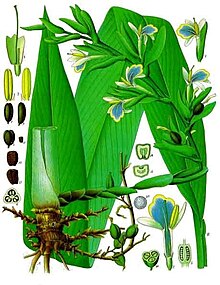Cardamon
| Cardamom | |
|---|---|
 |
|
| True cardamom (E. cardamomum) | |
 |
|
| Processed Cardamom pods | |
| Scientific classification | |
| Kingdom: | Plantae |
| (unranked): | Angiosperms |
| (unranked): | Monocots |
| (unranked): | Commelinids |
| Order: | Zingiberales |
| Family: | Zingiberaceae |
| Genera | |
Cardamom (/ˈkɑːrdəməm/), sometimes Cardamon or Cardamum, is a spice made from the seeds of several plants in the genera Elettaria and Amomum in the family Zingiberaceae. Both genera are native to India (the largest producer until the late 20th century), Bhutan, Indonesia and Nepal. They are recognized by their small seed pods: triangular in cross-section and spindle-shaped, with a thin papery outer shell and small black seeds; Elettaria pods are light green and smaller, while Amomum pods are larger and dark brown.
The first references to trade in cardamom from Sri Lanka, where it is grown on small scale in montane forests in the central mountain ranges, are from the 12th century CE. Nowadays, it is also cultivated in some other countries, such as Guatemala, Malaysia and Tanzania. The German coffee planter Oscar Majus Kloeffer introduced Indian cardamom (kerala) to cultivation in Guatemala before World War I; by 2000 that country had become the biggest producer and exporter of cardamom in the world, followed by India.
Cardamom is the world's third-most expensive spice, surpassed in price per weight only by vanilla and saffron.
The word "cardamom" is derived from the Latin cardamomum, which is the Latinisation of the Greek καρδάμωμον (kardamomon), a compound of κάρδαμον (kardamon), "cress" + ἄμωμον (amomon), which was probably the name for a kind of Indian spice plant. The earliest attested form of the word κάρδαμον signifying cress is the Mycenaean Greek ka-da-mi-ja, written in Linear B syllabic script, in the list of flavourings on the "Spice" tablets found among palace archives in the House of the Sphinxes in Mycenae.
...
Wikipedia
